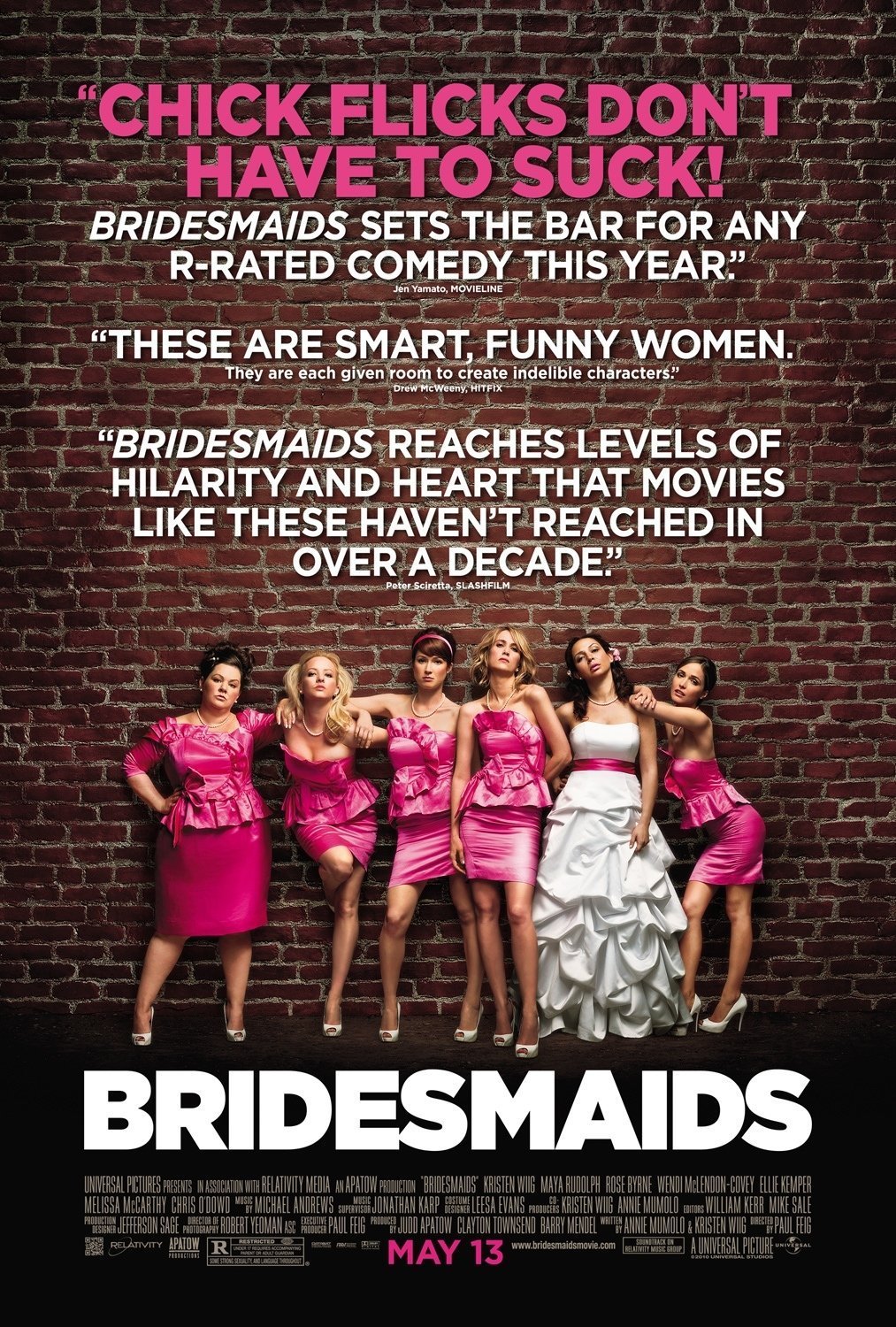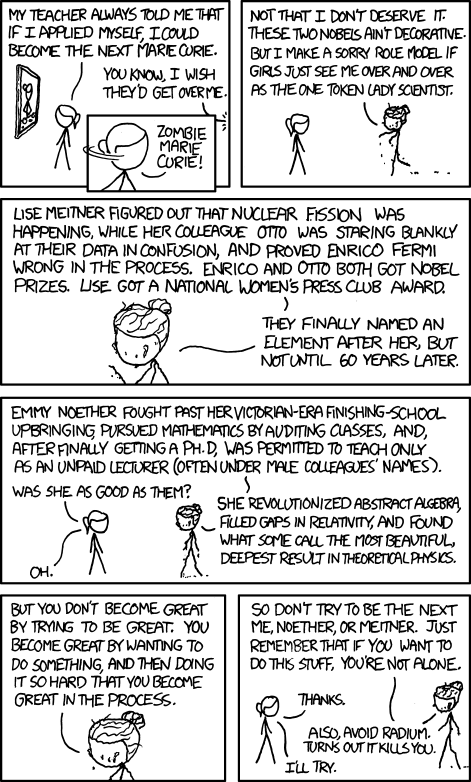That said, I'm interested in why a movie like Bridesmaids gets the Hue and Cry treatment, when it inhabits a fairly clear niche in the entire genre of "lady films". Is it that the film was not being marketed in the same upbeat movie cat-fighting advertising that accompanied say: Bride Wars?
Lets be fair, Bride Wars is a PG movie with a Tomatometer rating of 11% described as "Bride Wars takes the already wearisome concept of battling bridezillas, and makes it thoroughly insufferable via a lazy script and wholly detestable characters." and Bridesmaids rates an 89% on the Tomatometer and is described as "A marriage of genuine characters, gross out gags, and pathos, Bridesmaids is a female-driven comedy that refuses to be boxed in as Kristen Wiig emerges as a real star." So, quality of script is clearly a factor, as is the ambitiousness of the boundaries of the "Wedding Movie Genre."
 Lets take a sideline and discuss wedding movies in general. A subsection of the romance genre usually, there are a few highly successful and many less successful wedding movies out there. My Best Friend's Wedding, Made of Honor, 27 Dresses, Father of the Bride, etc... They all feature the event, which is one that even if an individual never gets married, they will probably attend or participate in at some time in their lives. Add a dash of the sheer complexity and expense of these events, the potential emotional tribulations that surround them and there you have a movie.
Lets take a sideline and discuss wedding movies in general. A subsection of the romance genre usually, there are a few highly successful and many less successful wedding movies out there. My Best Friend's Wedding, Made of Honor, 27 Dresses, Father of the Bride, etc... They all feature the event, which is one that even if an individual never gets married, they will probably attend or participate in at some time in their lives. Add a dash of the sheer complexity and expense of these events, the potential emotional tribulations that surround them and there you have a movie.
But that's just movies, there are literally networks devoted entirely to wedding shows, Bridezillas, Rich Bride, Poor Bride, A Wedding Story, Wedding SOS, not to mention Bridalplasty.
The preoccupation with marriage, the event, landing a partner, and of course, the temporary insanity that seems to descend on otherwise reasonable women, the bridezillas, is a genre that clearly has market value. Deliciously traditional with a dash of "every girl wants to be a princess" it is a "safe" genre for stories.
Bridesmaids set out to give that genre a sharp shock.
Kristin Wiig and writer, Annie Mumolo, had a charming and funny script that was then blended with Judd Apatow and Paul Feig's comedic stylings.
If Apatow was going to make a movie with Kristen Wiig, he made it clear, he wanted to capture the outrageousness that had made her a television star. “No, we’re not going to sit and talk,” Mumolo remembers Apatow saying about one scene of sedentary dialogue. The two female writers were occasionally wary about some suggestions made by Apatow and Feig — like a scene in which the bride and most of the bridesmaids come down with violent food poisoning. What were Wiig’s reservations? She shot a look. “Just that it was a huge scene about women vomiting” and defecating in their pants. “We wrote the script, and we didn’t really have anything in that tone, and it seemed to be such a big statement,” she says. Apatow assured her that if it did not work, they could cut it. Wiig and Mumolo — a writing partner from her Groundlings days — ultimately agreed that it did work.Paul Feig as director seemed to mediate the female voice and often over the top comedy elements:
From a Wall Street Journal interview with Paul Feig:
Because so many big female-driven comedies can be watered-down versions of male ones, how careful did you have to be to make sure that it wasn’t going to be a really funny girl version of “40-Year-Old Virgin”?So, what do we see here? People of both genders thinking about what they're doing and considerately making a movie that clearly appeals beyond the traditional market boundaries of the "Chick Flick." There was also a concerted effort to describe the film in a way that was accurate to its content. It isn't a standard chick flick, but while these ladies are sexy, they didn't single out the 'prettiest' and tart her up, nor did they attempt to overemphasize the scale of the shenanigans they get up to for shtick
What it just adds up to is they’re women talking like women and we’re not grafting anything on them other than potential story points or moments. Early on with Kristen and Annie and there were other women, we checked to make sure those story points were honest – what would be your honest reaction to this? And so it just kept us honest the whole time. I honestly don’t see how you can do it any other way if you’re working with a member of the opposite sex. Because I’m a pretty feminized geek, you know? I have that point of view, I grew up around a lot of girls, so I’m pretty sensitive to that. But I don’t dare say “I know how women think.”
 | ||||
Honestly, who wouldn't squish down their hair in that pose?
|
Universal crowed: "Bridesmaids has broken new ground in presenting an R-rated comedy designed for female audiences that also plays with male moviegoers – as opposed to traditional films in the R–rated comedy genre being targeted primarily for men. The film’s bigger than expected opening puts it in the category with other sleeper R-rated comedy openings such as The 40-Year-Old Virgin ($21.4m / $109.4m)."Nikki Finke is certainly not the only one surprised by the numbers, but that is a little sad. The idea that with the talent and energy put into this movie it wouldn't do at least reasonably gives me a serious case of the beleaguered sighs.
I was so convinced that this rare R-rated event comedy featuring women burping and farting for our female amusement wouldn't make over $13M, even $15M tops, that I promised Universal Pictures chairman Adam Fogelson that I would leave Hollywood reporting forever if Bridesmaids did the $20+ million he thought it would. Well, I've called the moving vans because I clearly have no idea what works at the domestic box office anymore.
Judd Apatow spoke to the The New York Times about what this means to women in the industry in general.
"Sadly, I think some of that talk was true. There are a lot of female-driven comedies on the bubble at the studios and they do look to measure how well these things do, and what levels of interest there are in certain genres. One of the reasons there was pressure is because the studios knew this movie came out very well, and if nobody bothered to go see it, they could say, "Even when you make a really good one, nobody comes." But because people came, the opposite lesson was learned, which is, there's an enormous neglected community of moviegoers who want to see films like this... I think they [the ensemble cast of Bridesmaids] all deserve to star in their own movies. It is usually a dearth of scripts which hold great actresses back. Hopefully the studios will develop more movies for them. As will I."So, unlike Amelia in 2009, this lady-driven movie succeeded. Is it a factor in the sudden increase in female created scripts picked up for the fall TV lineup? (in my heart of hearts I hope not) Does it mean there should be a corresponding increase in scripts by ladies being picked up? only if they're good. It's a shame that every time a movie with a lot of female characters or writers or dare I say it, directors must stand exemplar for all women in the business. By that logic I demand we hold all movies by male directors to the standards of Bubble Boy and Battlefield Earth.
"Women must pay for everything.
They do get more glory than men for comparable feats,
but, they also get more notoriety when they crash."
-Amelia Earhart
-Amelia Earhart
It is my ardent hope that someday that quote will truly be the hallmark of an era that we have passed beyond.
Update: Bridesmaids is poised to become Judd Apatow's highest ever box-office hit
Update: Bridesmaids is poised to become Judd Apatow's highest ever box-office hit













